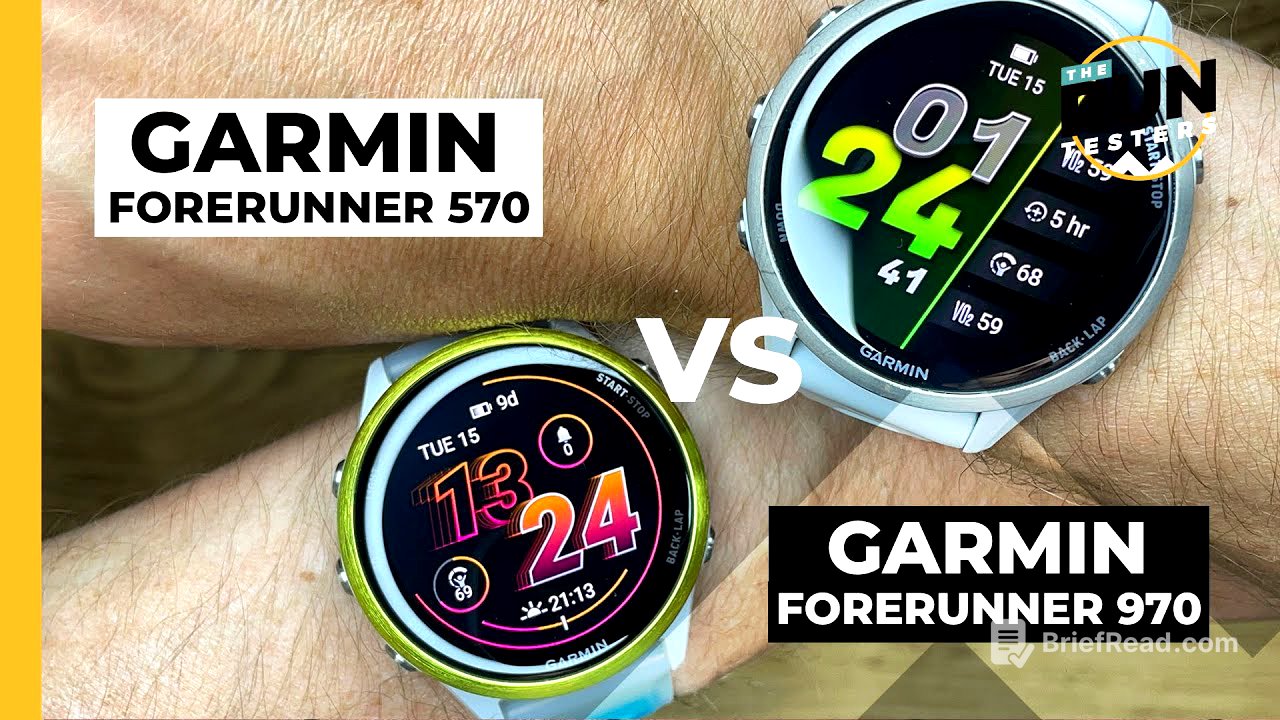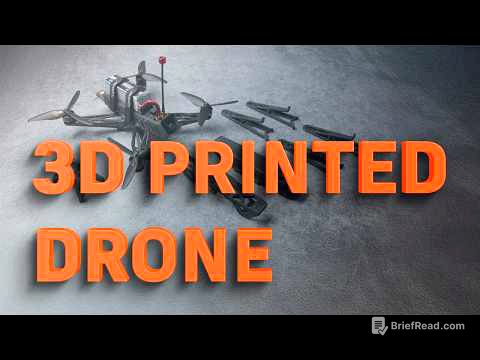TLDR;
This video provides a detailed comparison between the Garmin Forerunner 970 and 570, two high-end running watches. It covers their key specs, features, differences, performance in real-world running scenarios, and overall value. The review highlights that both watches are highly capable, with the 970 offering more advanced features and better durability at a higher price, while the 570 provides similar core tracking performance at a more accessible price point.
- The Forerunner 970 and 570 both feature AMOLED screens, dual-frequency GPS, and the latest heart rate sensors.
- The 970 includes advanced running metrics, full-colour topographic maps, and a built-in flashlight, while the 570 offers a similar core running experience at a lower cost.
- Battery life is better on the 970, but both watches require frequent charging due to the power-intensive AMOLED displays.
Intro [0:00]
The video introduces a head-to-head comparison of the Garmin Forerunner 970 and 570. Both watches boast crisp AMOLED screens, dual-frequency GPS, and the latest optical heart rate sensors, along with microphones and speakers for voice tools. The review aims to determine which watch is the better choice for runners, considering their similar suite of training, racing, and recovery tools.
Forerunner 970 vs 570: What’s the difference? [0:31]
The Forerunner 970 succeeds the 965, while the 570 replaces the 255 and marks the end of the 2 series. Both watches feature dual-band GPS technology and the latest Gen 5 optical sensor, but the 970 includes ECG smarts, which the 570 lacks. The 570 is available in 42mm and 47mm sizes, while the 970 only comes in a 47mm model. The 970 weighs 56 grams, while the 570 is lighter, at 42 or 50 grams depending on the size. Battery life varies, with the 970 offering up to 15 days in smartwatch mode and 21 hours in max GPS mode, compared to the 570's 10 days and 14 hours, respectively. The 970 uses premium materials like a sapphire display and titanium bezel, while the 570 has Gorilla Glass 3 and an aluminium bezel. Both are water-resistant to 50 meters, but the 970 has a front-facing flashlight, which the 570 does not. The core running experience is similar on both, with comprehensive training, coaching, racing, and recovery tools. The 970 includes advanced running metrics like running economy and step speed loss (requiring an HRM-Pro chest strap) and running tolerance. Both offer smartphone notifications, weather updates, offline music, contactless payments, and voice commands. The 970 has full-colour topographic offline maps, while the 570 uses breadcrumb navigation. The 970 costs $749.99 in the US and £629.99 in the UK, while the 570 is priced at $459.99 or $549.99 in the US, or approximately £460.
The Run Test [3:46]
The reviewer tested the 570 (47mm) and 970 for around three months, comparing them against each other and other watches like the Phoenix 8 for heart rate and GPS accuracy. Tests included the 55-mile Comrades Marathon and a 10K race in Central London. The controls, user interface, and wearability are comparable between the two watches, with snappy and responsive touchscreens and a user-friendly interface. The AMOLED screens are brighter and crisper. The 570 has a more colourful and sporty design, while the 970 is more subtle. The 570 feels slightly cheaper, and the reviewer would have preferred a sapphire display on it. In terms of GPS accuracy, the 570 logged 10.14 km and the 970 logged 10.28 km on a twisty 10K course, while the Phoenix 8 logged 10.25 km. During the Comrades Marathon (89.98 km), the watches were within 80 meters of each other, recording between 90.71 and 90.79 km. Heart rate performance was solid for both, closely matching the HRM-Pro chest strap, with only occasional erroneous spikes or drops. Battery life differed, with the 570 burning 55% and the 970 burning 39% during the 9-hour Comrades Marathon in max accuracy GPS mode with always-on screen and max brightness. In typical use with the highest settings, the 970 consumed around 4% of battery per hour, while the 570 consumed 6%. Both watches likely require charging every four to five days with regular training, indicating a trade-off for the AMOLED display.
Verdict: What’s the best Garmin running watch? [6:37]
Both the Forerunner 970 and 570 are highly capable running watches, but come at a premium price. The 570's price increase positions it closer to premium watches, despite competition from cheaper rivals like the Sunto Race 2, Coros Pace 3, and Polar Vantage V3. The 970 offers capabilities close to the Phoenix series in a more wearable design. The decision between the two depends on whether the extra features of the 970—offline mapping, ECG, longer battery life, running tolerance, step loss, running economy, tougher display, and built-in flashlight—justify the higher cost. The 970 is the more well-rounded and durable option with greater tracking capabilities. If these features are not essential, the 570 offers similar day-to-day usability and tracking performance for less money. The reviewer found the running tolerance estimate useful but considered the other advanced running metrics not insightful enough to warrant the extra expense, especially considering the additional cost of the HRM chest strap required to unlock them.
Now watch this… [8:34]
The video concludes by encouraging viewers to like and subscribe for more content. Individual reviews of the Forerunner 970 and 570 are available on the channel, as well as a video discussing the best Garmin watches currently available.









